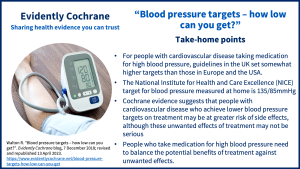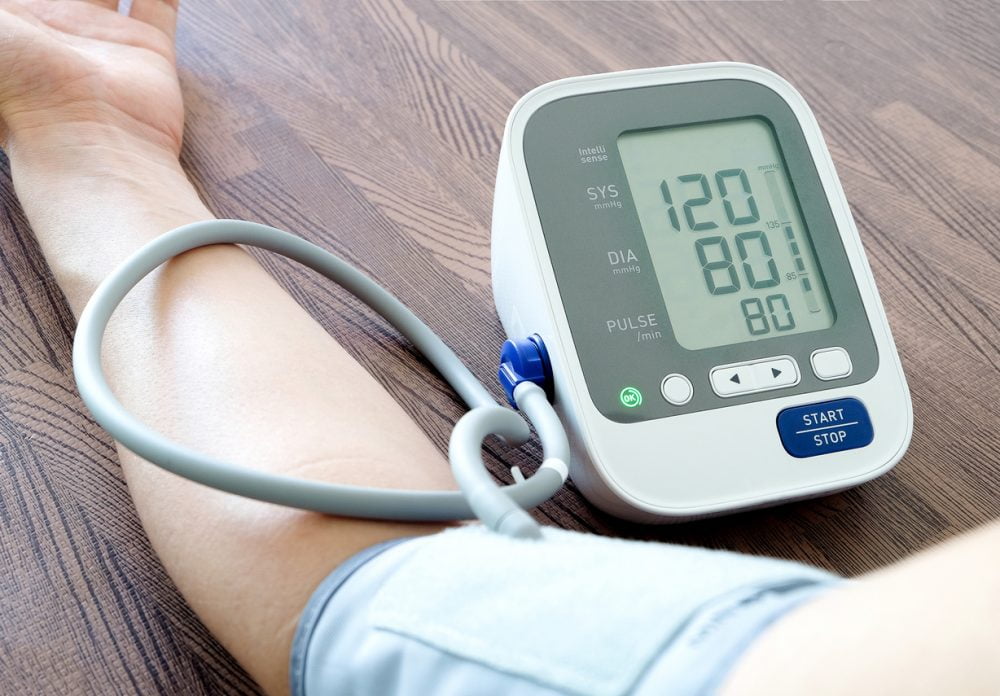In this blog for people with cardiovascular disease taking treatmentSomething done with the aim of improving health or relieving suffering. For example, medicines, surgery, psychological and physical therapies, diet and exercise changes. for high blood pressure, Robert Walton, a Cochrane UK Senior Fellow in General Practice, looks at the latest Cochrane evidenceCochrane Reviews are systematic reviews. In systematic reviews we search for and summarize studies that answer a specific research question (e.g. is paracetamol effective and safe for treating back pain?). The studies are identified, assessed, and summarized by using a systematic and predefined approach. They inform recommendations for healthcare and research. on what blood pressure targets to aim for, balancing the benefits of treatment against the riskA way of expressing the chance of an event taking place, expressed as the number of events divided by the total number of observations or people. It can be stated as ‘the chance of falling were one in four’ (1/4 = 25%). This measure is good no matter the incidence of events i.e. common or infrequent. of side effects.
Originally published: 5 October 2018. Revised and republished: 13 April 2023 to reflect the latest guidance and Cochrane evidence.
Take-home points

So you want to stay healthy and live to a ripe old age? But the doctor says your blood pressure is too high and you have started taking medication to bring it down. What should your blood pressure be and when do you stop trying to make it lower?
These are really important questions but until recently there was very little evidence on which to base your decision. Now there is an updated Cochrane Review that could help you to decide what your blood pressure target should be (Saiz et al. 2022), so you know what goal you need to achieve to reduce the chances of problems in the future.
But first, let’s have a look at existing recommendations for blood pressure targets and then see where the new review takes us.
A US perspective on blood pressure

An influential report by the American College of Cardiology and American Heart AssociationA relationship between two characteristics, such that as one changes, the other changes in a predictable way. For example, statistics demonstrate that there is an association between smoking and lung cancer. In a positive association, one quantity increases as the other one increases (as with smoking and lung cancer). In a negative association, an increase in one quantity corresponds to a decrease in the other. Association does not necessarily mean that one thing causes the other. a few years ago reflected the views of some doctors both in the US and in Europe that blood pressure targets are currently set too high (Whelton et al, 2017). So, experts were thinking that many people would benefit from lower blood pressure than they are currently achieving.
Aiming for lower blood pressure seems to make sense because we know from large studies in different populations that the risk of heart disease and stroke rises steadily as blood pressure increases and, although there has been some debate on the subject, people with the lowest blood pressures generally are at lowest risk (Rapsomaniki et al, 2014).
So, does all that apply to people who have already had problems with cardiovascular disease who are taking blood pressure treatment? Well, the US guidelines presume that it does and suggest that blood pressure should be kept below 130/80. This new guidance (2022) caused a stir since doctors and patients alike began to wonder how the targets can be achieved.
Many people already take two or more drugs to control their blood pressure and would need higher doses or extra medication to move their blood pressure below the new target. With the increased medication load comes an increased risk of side effects and people may want to balance the benefits in the reduction of cardiovascular disease against the unwanted effects of drugs.
Is Europe in agreement with lower blood pressure targets?
Having previously recommended much higher targets than the USA, European guidelines (2021) have now become much more ambitious. Whilst agreeing with the US position that 130/80 should be a general target, the Europeans go further saying that in people under the age of 66 efforts should still be made to reduce blood pressure, acknowledging that many people can achieve systolic blood pressure less than 120mmHg without unwanted effects.
What about the guidance in the UK?
The National Institute for Health and Care Excellence (NICE) recently updated its advice (2022) which is neatly summarised in this visual summary. Perhaps as a result of the Covid pandemic most people in the UK tend to take their own blood pressure at home now and NICE has set the target for home blood pressure at 135/85, so somewhat higher than Europe and the USA.
So where does that leave us?
This helpful Cochrane ReviewCochrane Reviews are systematic reviews. In systematic reviews we search for and summarize studies that answer a specific research question (e.g. is paracetamol effective and safe for treating back pain?). The studies are identified, assessed, and summarized by using a systematic and predefined approach. They inform recommendations for healthcare and research., updated in November 2022, looks specifically at whether risk of death is lower in people with cardiovascular disease who achieve lower blood pressure targets. In this review, the lower target blood pressure was defined as 135/85. The review went on to assess the risk of unwanted effects from blood pressure treatment by looking at the number of people who dropped out of trialsClinical trials are research studies involving people who use healthcare services. They often compare a new or different treatment with the best treatment currently available. This is to test whether the new or different treatment is safe, effective and any better than what is currently used. No matter how promising a new treatment may appear during tests in a laboratory, it must go through clinical trials before its benefits and risks can really be known. because of drug side effects.
Interestingly there was probably little or no difference in risk of death in people in the lower blood pressure target group compared to those in the standard target group. More people may have needed to leave the studies because of unwanted effects when they tried to achieve the lower blood pressure targets although there may be no increase in serious side effects.
Currently, then, there is no Cochrane evidence to suggest a benefit in aiming for lower blood pressure as suggested by the US and the EU. But several trials are in progress that will give us more detailed information on this important issue.
Join in the conversation on Twitter with @CochraneUK or leave a comment on the blog.
Robert Walton has nothing to disclose.



Exploring blood pressure targets’ impact on health outcomes. This evidence-based piece highlights the ongoing debate about optimal blood pressure levels and their influence on various health conditions. A balanced overview of medical perspectives to inform individuals and healthcare professionals.
I completely agree with the author’s perspective on the importance of balancing the benefits of high blood pressure treatment against the risk of side effects. The updated Cochrane Review provides valuable information for people with cardiovascular disease who are taking medication for high blood pressure to make informed decisions about their blood pressure targets. It is interesting to note that the European guidelines have become more ambitious in recommending efforts to reduce blood pressure, while the UK sets somewhat higher targets. The review highlights the need for more research to determine the benefits of aiming for lower blood pressure targets in people with cardiovascular disease.
As a caretaker, I have been doing at-home blood pressure readings and trying to help sort out with the family physician the dosage vs dizzy side effects that may have resulted in a fall. Thank you for another interesting blog!
113/072
Is this a normal reading?
Is it too low or just right?
I’m afraid we can’t comment on individuals; you’d need to ask your clinician.
Best wishes,
Sarah Chapman [Editor]